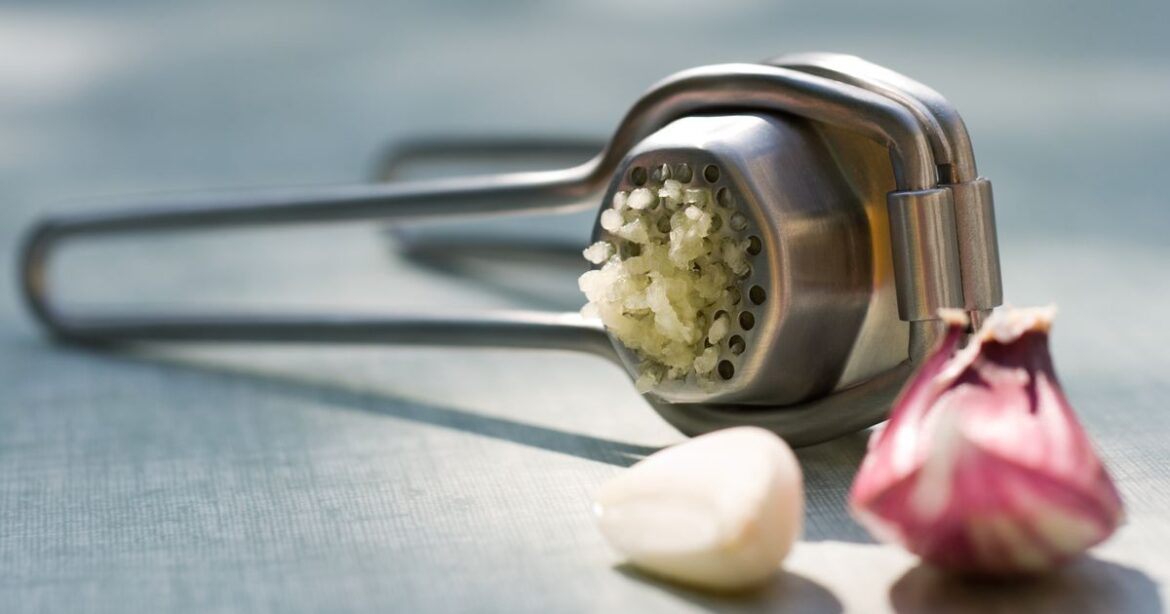Table of Contents
Once upon a time, garlic presses were a hot property. They were the perfect accessory for a cook who bought low-fat everything, loaded up on carbs and had a fresh pasta maker in the pantry. But as times changed and food fads did too (goodbye Snackwells, hello keto), the once-trendy garlic press fell out of favor.
In his memoir “Kitchen Confidential,” the late Anthony Bourdain called garlic presses “abominations” and advised, “Don’t put it through a press. I don’t know what that junk is that squeezes out of the end of those things, but it ain’t garlic.”
In a recent TikTok entitled “Everybody’s Wrong About Using A Garlic Press,” Christopher Kimball of Milk Street offered his hot take on garlic presses, saying that Italians don’t use them. According to him, “If you go to Italy, you never get garlic breath because they don’t use garlic presses there; they do it the right way.” Unable to smell the breath of all 59 million people who live in Italy, we set out to do some research of our own.
Garlic contains a key compound called allicin.
Garlic bulbs grow underground and have a “secret weapon” to protect themselves. It’s allicin, an organosulfur compound. Olivia Roszkowski, a chef-instructor at the Institute of Culinary Education, says, “It’s a natural line of defense to avoid critters from finding it desirable to consume.”
Whether it’s a chipmunk taking a tentative bite of a clove in your backyard garden or your own chef’s knife coming down to slice it up, the same thing happens whenever the cellular structure of garlic is broken: allicin is created. “That happens when the enzyme alliinase, found in the garlic’s casing, interacts with alliin, found in the cloves, to generate allicin,” said chef Nettie Colon.
And allicin stinks.
Allicin is a nutritional superstar long touted for its immune-boosting and cancer-fighting compounds. But it also smells — sometimes, a lot. “That sulfur-like smell is what the plant produces basically to defend itself,” Colon said.
And once you’ve eaten it, that allicin will start to have an effect. “Inside the body, allicin produces methyl mercaptan, a colorless gas, which is what comes out of the mouth after we eat garlic,” Colon said.
To place the blame where it clearly belongs, Richard LaMarita, chef-instructor of plant-based culinary arts at the Institute of Culinary Education, said: “Yes, allicin is the basic cause of garlic breath,” he said. “The aromatic compounds from garlic, stemming from allicin, move into the gut and bloodstream and from there into the lungs, where they can remain for a day or two.”
It’s smelly but good for you.
Allicin will be released whenever a clove’s cells are broken, whether sliced, pressed or mashed. How do you know allicin is being released? “You might notice a sticky liquid when cutting garlic for an extended amount of time,” Roszkowski said. “That liquid is full of the volatile compound allicin.”
But the amount of allicin released can vary by prep method. The more the cells are damaged, the more allicin is released, resulting in stronger flavor and aroma. “Using a garlic press or crusher will expose the largest amount of allicin,” she added.
It may stink, but you have to love allicin for its many health benefits. You may even be willing to be a bit more odorous as a tradeoff. Colon shared a hack to boost those benefits even more: “You can increase the active amount of allicin by waiting at least 10 minutes after it’s cut up before you expose it to heat,” she said.
Here’s when a garlic press is a good idea.
After years in the culinary backwaters, the garlic press could be due for a reconsideration. Some chefs are returning the much-maligned utensil to a place of honor in their batterie de cuisine. That’s because, they say, there are times when thoroughly pressed garlic can actually improve the flavor of a dish.
Why? Well, no matter what Kimball thinks about the collective oral health of an entire Mediterranean peninsula, some people actually like a robust garlic flavor in their food, and they don’t mind if that means a bit of extra brushing or mouthwashing after a meal is done.
If those “liberate the garlic!” types pull out a garlic press when no one’s looking, that’s certainly their choice. Those who prefer milder flavors are free to thinly slice cloves or even to just rub the cut edges of a clove around serving dishes or bowls.
If your knife skills are less than stellar, you might appreciate how a garlic press uniformly breaks down the cloves. And if you’re looking for a consistent garlic flavor in each bite of a dish, you might want to use a press, too. Just be ready to tell everyone how allicin, that organosulfur compound, is your showstopping dish’s real “secret ingredient” of your showstopping dish.
Related: If you’re terrible at peeling garlic, we’ve found a game-changer. Click here to read all about this popular $7 product.
HuffPost and its publishing partners may receive a commission from some purchases made via links on this page. Every item is independently curated by the HuffPost Shopping team. Prices and availability are subject to change.


